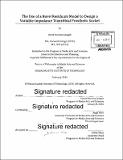| dc.contributor.advisor | Hugh Herr. | en_US |
| dc.contributor.author | Sengeh, David Moinina | en_US |
| dc.contributor.other | Program in Media Arts and Sciences (Massachusetts Institute of Technology) | en_US |
| dc.date.accessioned | 2016-12-22T16:27:41Z | |
| dc.date.available | 2016-12-22T16:27:41Z | |
| dc.date.copyright | 2016 | en_US |
| dc.date.issued | 2016 | en_US |
| dc.identifier.uri | http://hdl.handle.net/1721.1/106069 | |
| dc.description | Thesis: Ph. D., Massachusetts Institute of Technology, School of Architecture and Planning, Program in Media Arts and Sciences, 2016. | en_US |
| dc.description | Cataloged from PDF version of thesis. | en_US |
| dc.description | Includes bibliographical references (pages 74-77). | en_US |
| dc.description.abstract | For people living with limb amputation, the prosthetic socket - the interface between the residuum and prosthesis - is the most critical component. When a socket is uncomfortable, especially due to poor fit, the quality of life for a patient is greatly hindered. However, conventional design of sockets is largely artisan, with limited input of quantitative data. Current computer-aided and manufacturing (CAD/CAM) designs are still not clinically applicable solutions. Due to model identification procedures that employ non patient-specific and incomplete data sets, today's finite element (FE) models of the residuum are not predictive, leading to suboptimal socket designs. As such, there exists a need for a comprehensive biomechanical model of the residuum for the quantitative design and computational evaluation of patient-specific prosthetic sockets. This thesis presents a combined experimental-numerical approach to evaluate and validate a transtibial residuum biomechanical model. The central hypothesis of the work is that a single biomechanical model can predict the large non-linear response at various sites on a residuum under load. To evaluate this hypothesis, a non-linear, two-tissue model was formulated where tissue geometries were defined using MRI data of the residuum. The non-linear viscoelastic material parameters of the model were identified through inverse FEA-based optimization using in-vivo indentation experimental data at four locations. Using optimized model tissue parameters, the mean percentage error (mean absolute error/ maximum experimental force) between the experimental and simulation force-time curves at 14 other locations across the evaluated transtibial residuum was 7 ± 3%. Using this same modeling methodology and a single set of material constants to describe the bulk soft tissue biomechanical response of seven distinct transtibial residual limb models, the average percentage error for indentations at multiple locations across all seven limbs was 7 ± 1%. From these predictive models of residuum limbs, one rigid novel socket and two multimaterial transtibial sockets were designed, fabricated and evaluated through an entirely quantitative, automated and repeatable methodology. In a preliminary clinical investigation, the novel sockets were shown to reduce peak contact pressures at the tibia and fibular head regions on the residuum by significant amounts during standing compared to a conventional socket interface designed and fabricated by a trained prosthetist. | en_US |
| dc.description.statementofresponsibility | by David Moinina Sengeh. | en_US |
| dc.format.extent | 77 pages | en_US |
| dc.language.iso | eng | en_US |
| dc.publisher | Massachusetts Institute of Technology | en_US |
| dc.rights | M.I.T. theses are protected by copyright. They may be viewed from this source for any purpose, but reproduction or distribution in any format is prohibited without written permission. See provided URL for inquiries about permission. | en_US |
| dc.rights.uri | http://dspace.mit.edu/handle/1721.1/7582 | en_US |
| dc.subject | Program in Media Arts and Sciences () | en_US |
| dc.title | The use of a novel residuum model to design a variable-impedance transtibial prosthetic socket | en_US |
| dc.type | Thesis | en_US |
| dc.description.degree | Ph. D. | en_US |
| dc.contributor.department | Program in Media Arts and Sciences (Massachusetts Institute of Technology) | en_US |
| dc.identifier.oclc | 965194757 | en_US |
